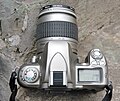History and design
The Nikon F75 was released in February 2003 and was positioned as an entry-level autofocus film SLR aimed at budget-conscious consumers. While it shares design language and some core features with the Nikon N80 (F80), the F75 is a more streamlined version with a lighter, largely plastic build. The camera was offered in silver or black and retailed for approximately $300 with a lens, with rebates commonly available. Body-only versions sold for around $190.
The F75's features include depth-of-field preview, illuminated LCDs, pop-up flash, and multiple user-friendly exposure modes. The N75 also has new features, such as a 25 segment meter and a battery level indicator in the viewfinder. A version designated the F75 QD (or N75 QD in the U.S.) featured a built-in quartz date back for imprinting the date onto photographs. The N75 is compatible with most Nikon F-mount lenses, including AF, AF-D, AF-S, VR, Ai, and Ai-S types. It does not support pre-Ai lenses, which cannot be mounted without risking damage. Autofocus functions with screw-drive lenses, so a built-in motor is not required for AF operation. The F75 uses two CR2 lithium batteries.
Despite the advanced design and low cost, the Nikon F75 was released around the time digital cameras became mainstream, and its release was overshadowed by Nikon's more successful DSLRs, the Nikon D100 and D70. It was discontinued in January 2006, but it is still sold cheaply on the used market, and is valued because it can drive Nikon's newest F-mount lens designs. [1]
This page is based on this
Wikipedia article Text is available under the
CC BY-SA 4.0 license; additional terms may apply.
Images, videos and audio are available under their respective licenses.



